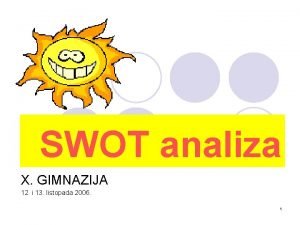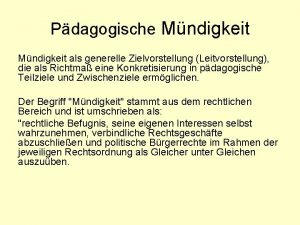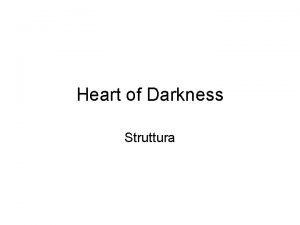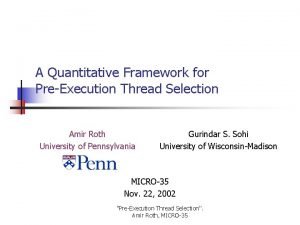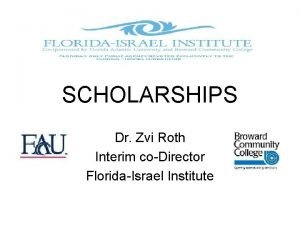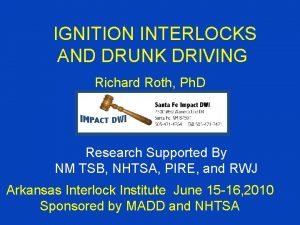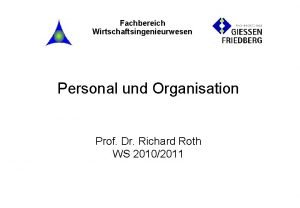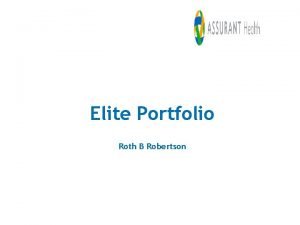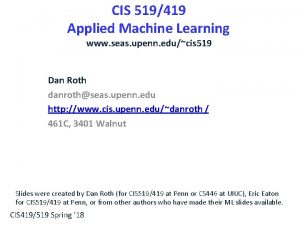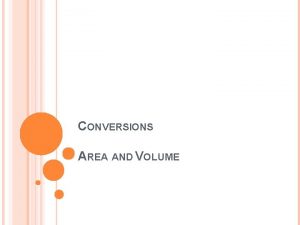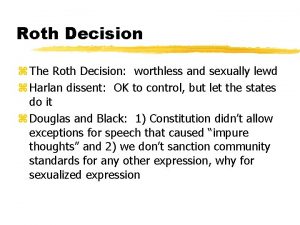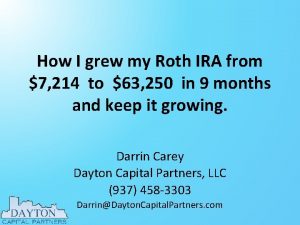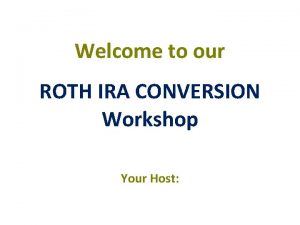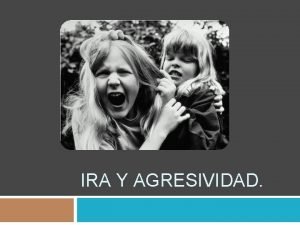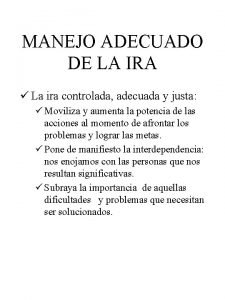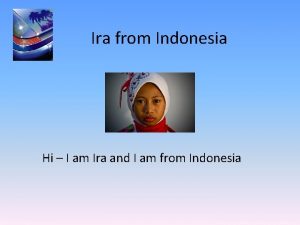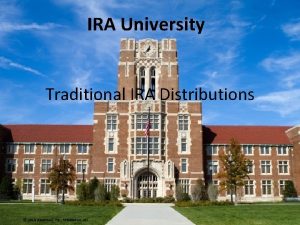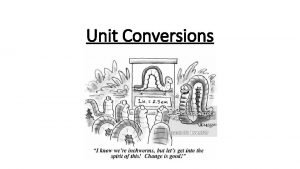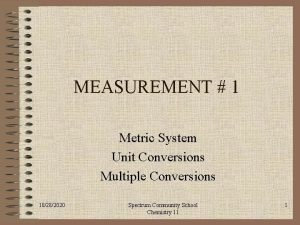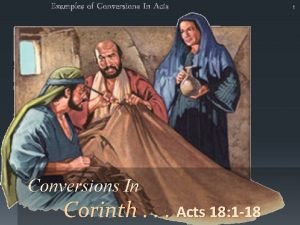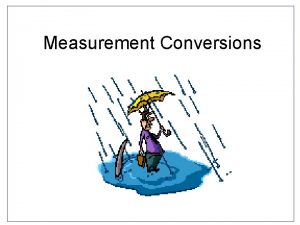Roth IRA Conversions Opportunities for 2019 Introduction to


























- Slides: 26

Roth IRA Conversions Opportunities for 2019

Introduction to Roth IRAs Contributions are made on an after-tax basis There’s no up-front tax benefit Qualified distributions are entirely free from federal income tax Caution: Different rules may apply for state tax purposes

Traditional IRA vs. Roth IRA Traditional IRA Can make annual contribution if under age 70½ and have taxable compensation Deductible contributions depend on income, filing status, and coverage by retirement plan Can make after-tax (nondeductible) contributions Distributions subject to federal income tax, except for after-tax contributions Distributions prior to age 59½ may be subject to additional 10% penalty tax Distributions required after 70½ Funds grow tax deferred Roth IRA Can make annual contribution if you have taxable compensation; no age limit Ability to contribute depends on income level and filing status All contributions are after-tax (no up-front deduction) Qualified distributions are entirely free from federal income taxes For nonqualified distributions, earnings subject to federal income tax and 10% penalty tax may apply if under age 59½ No lifetime required distributions Funds grow tax deferred/tax free

Roth Tax-Free Qualified Distributions Qualified distributions are federal income tax free. For a distribution to be qualified, it must meet BOTH of the following requirements: Satisfy five-year holding period AND Have qualifying event Age 59½ Disability First-time homebuyer expenses (limited to $10, 000 lifetime from all IRAs) Death

Roth Qualified Distributions: The Five-Year Holding Period Five-year holding period begins on the first day of tax year for which you first made a contribution (annual, rollover, or conversion) to ANY Roth IRA Five-year holding period ends after five calendar years Applies to your beneficiaries after your death as well Spouse beneficiary can roll over to own Roth IRA or treat your Roth IRA as his or her own. In either case, the five-year holding period begins on the earlier of: January 1 of tax year your spouse first established any Roth IRA, or January 1 of tax year you first established any Roth IRA Period begins on January 1 of first tax year for which you made a contribution to any Roth IRA • Can make a regular (annual) contribution to an IRA for a tax year until April 15 of following year • If you make regular contribution to first Roth IRA on April 15, 2020, and designate contribution for 2019, five-year holding period begins on January 1, 2019

Qualified Distributions — Example 1 Age 60 Establish first Roth IRA on December 31, 2019, by converting a traditional IRA to a Roth IRA Must have qualifying event AND satisfy five-year holding period Here qualifying event has occurred — you’ve attained age 59½ Five-year holding period begins January 1, 2019 Five-year holding period ends December 31, 2023 Tax-free qualified withdrawals from this Roth IRA, and any other Roth IRA you own, available anytime after December 31, 2023 5 -year period Establish first Roth starts 1/1/2019 IRA 12/31/2019 Qualifying event 59½ 5 -year period ends 12/31/2023 Tax-free distribution after 12/31/2023

Qualified Distributions — Example 2 Age 35 Establish first Roth IRA on June 1, 2019, by making a rollover from a 401(k) plan to the Roth IRA Must have qualifying event AND satisfy five-year holding period Five-year holding period begins January 1, 2019 Five-year holding period ends December 31, 2023 Tax-free qualified withdrawals available from this Roth IRA, and any other Roth IRA you own: In 2043, after you attain age 59½ After December 31, 2023, if you become disabled or die* After December 31, 2023, if you have first-time homebuyer expenses (up to $10, 000 lifetime from all IRAs)* 5 -year period starts 1/1/2019 Establish first Roth IRA 6/1/2019 5 -year period ends 12/31/2023 *Tax-free distribution after 12/31/2023 Qualifying event 59½ in 2043 Tax-free distribution

Qualified Distributions — Example 3 You inherit a Roth IRA from your mother in 2019 Your mother established her first Roth IRA in 2016 by making a regular annual contribution Must have qualifying event AND satisfy five-year holding period Qualifying event is your mother’s death Five-year holding period begins January 1, 2016 Five-year holding period ends December 31, 2020 Tax-free qualified withdrawals are available from the inherited Roth IRA anytime after December 31, 2020 5 -year period starts 1/1/2016 Mother establishes first Roth IRA in 2016 Qualifying event in 2019 mother’s death 5 -year period ends 12/31/2020 Tax-free distribution after 12/31/2020

Nonqualified Roth Distributions Nonqualified distribution: You haven’t satisfied the five-year holding period or you don’t have a qualifying event Your contributions come out tax free Your contributions come out first Taxable earnings come out last Earnings are subject to income tax, and 10% penalty tax unless exception applies

Ways to Fund a Roth IRA Regular Annual Contributions Rollover from Eligible Employer Plan to Roth IRA Convert Traditional IRA to Roth IRA

Converting a Traditional IRA to a Roth IRA Taxed in year of conversion as if you took a withdrawal (but 10% early distribution does not apply) Trade off immediate taxation for possibility of tax-free qualified distributions in future You can also convert SIMPLE IRAs (after two-year waiting period) and SEP-IRAs to Roth IRAs

Ways to Convert a Traditional IRA to a Roth IRA Rollover Trustee-to-trustee transfer Same-trustee transfer

Calculating the Conversion Taxes Taxed as if you took a withdrawal from the traditional IRA 10% penalty tax doesn’t apply (but may be recaptured if you make a nonqualified withdrawal from your Roth IRA within five years of any conversion)

Calculating the Conversion Taxes If you’ve made only deductible contributions to your traditional IRAs, then the entire amount you convert is subject to income tax. IRA Only deductible contributions and earnings = Fully taxable conversion

Calculating the Conversion Taxes IRA TAXABLE Deductible contributions and earnings NONTAXABLE Non-deductible contributions If you’ve made nondeductible (after-tax) contributions to your traditional IRA, any distribution consists of pro rata amount of taxable and nontaxable dollars Can’t just convert nontaxable dollars in a traditional IRA for tax-free conversion

Calculating the Conversion Taxes IRA #1 TAXABLE Deductible contributions and earnings NONTAXABLE Non-deductible contributions

Calculating the Conversion Taxes IRA Must aggregate all traditional IRAs you own, including SEP and SIMPLE IRAs, when calculating the taxable amount of a withdrawal or conversion TAXABLE Deductible contributions and earnings NONTAXABLE Non-deductible contributions

Calculating the Conversion Taxes $100, 000 Traditional IRA #1 Deductible contributions and earnings $20, 000 Traditional IRA #2 Nondeductible contributions If you convert IRA #2 to a Roth you’ll have $16, 667 of taxable income First aggregate all traditional IRAs = $120, 000 total balance Then determine taxable percentage = 83⅓% ($100, 000/$120, 000) Then calculate taxable portion of IRA conversion = $16, 667 ($20, 000 x 83⅓%)

Who Can Convert to a Roth? Before 2010, no conversion if: Income greater than $100, 000 (whether filing jointly or single), or Married filing separate tax returns 2010 and beyond Anyone can convert Exception You can’t convert an inherited traditional IRA to a Roth IRA (special rules apply to spouse beneficiaries)

Converting Employer Plan Dollars to a Roth IRA Eligible distributions from 401(k), 403(b), 457(b), and qualified plans can be rolled over to traditional or Roth IRA Your employer will identify an eligible rollover distribution Amounts rolled over to a Roth IRA are taxed except for any after-tax contributions After 2009, anyone can roll over to a Roth IRA, regardless of income limits or marital status — even non-spouse beneficiaries Rollovers from employer plans can be complicated, and can have serious tax implications

Funding Annual Roth Contributions You can contribute up to $6, 000 to a Roth IRA in 2019 Individuals age 50 or older can make additional “catchup” contribution of $1, 000 Annual contributions may be limited depending on income level and filing status: Federal filing status 2019 Roth contribution reduced if MAGI is: You can’t contribute to a Roth IRA in 2019 if your MAGI is: Single or head of household More than $122, 000 but less than $137, 000 or more Married filing jointly or qualifying widow(er) More than $193, 000 but less than $203, 000 or more Married filing separately More than $0 but less than $10, 000 or more

Using the “Back Door” to Fund Annual Roth Contributions Even if you can’t contribute to a Roth IRA because of the income limits, you can contribute to a traditional IRA if you’re under age 70½ Anyone can convert a traditional IRA to a Roth after 2009, regardless of income or marital status You can make nondeductible contributions initially to a traditional IRA Convert that traditional IRA to a Roth Remember to aggregate your traditional IRAs when calculating tax Up to $6, 000 in 2019 ($7, 000 if age 50 or older) First contribute to: Traditional IRA Roth IRA Then convert to:

Is a Roth Conversion Right for You? Pros Beneficial if you expect to be in a higher tax bracket when you take payouts Qualified distributions are tax free, won’t impact Social Security Lifetime distributions not required; more assets can compound tax free for longer time May be able to leave more to heirs, income tax free

Is a Roth Conversion Right for You? Cons May not be appropriate if you expect to be in a lower tax bracket when you’ll take payouts You pay taxes now; potential negative impact on Social Security, other items Using IRA funds to pay conversion taxes may have serious drawbacks May not be appropriate if you’ll need to use the funds soon Risk of future law changes State tax treatment may differ

Thank You

Disclaimer IMPORTANT DISCLOSURES Broadridge Investor Communication Solutions, Inc. does not provide investment, tax, or legal advice. The information presented here is not specific to any individual's personal circumstances. To the extent that this material concerns tax matters, it is not intended or written to be used, and cannot be used, by a taxpayer for the purpose of avoiding penalties that may be imposed by law. Each taxpayer should seek independent advice from a tax professional based on his or her individual circumstances. These materials are provided for general information and educational purposes based upon publicly available information from sources believed to be reliable—we cannot assure the accuracy or completeness of these materials. The information in these materials may change at any time and without notice. Securities and investment advice offered through Investment Planners, Inc. (Member FINRA/SIPC) and IPI Wealth Management, Inc. , 226 W. Eldorado Street, Decatur, IL 62522. 217 -425 -6340.
 Tim roth and lori baker
Tim roth and lori baker Primerica ira roth
Primerica ira roth Backdoor roth ira conversion white coat investor
Backdoor roth ira conversion white coat investor Ira hayes high school
Ira hayes high school Lutz sperling
Lutz sperling Marija roth psiholog
Marija roth psiholog Artikulationsschema grell
Artikulationsschema grell Eli the fanatic summary
Eli the fanatic summary Dan roth upenn
Dan roth upenn Nervo interosseo posteriore
Nervo interosseo posteriore Heinrich roth mündigkeit
Heinrich roth mündigkeit Keely roth
Keely roth Dan roth upenn
Dan roth upenn Tim roth heart of darkness
Tim roth heart of darkness Stefan roth rwth
Stefan roth rwth Amir roth
Amir roth The metamorphosis movie 1987
The metamorphosis movie 1987 Arnd roth
Arnd roth John reece roth
John reece roth Zvi roth
Zvi roth Dick roth
Dick roth Lesezentrum gehirn
Lesezentrum gehirn Being safe
Being safe Polyzentrischer ansatz
Polyzentrischer ansatz Roth robertson
Roth robertson Dan roth upenn
Dan roth upenn Iso 22301 utbildning
Iso 22301 utbildning





